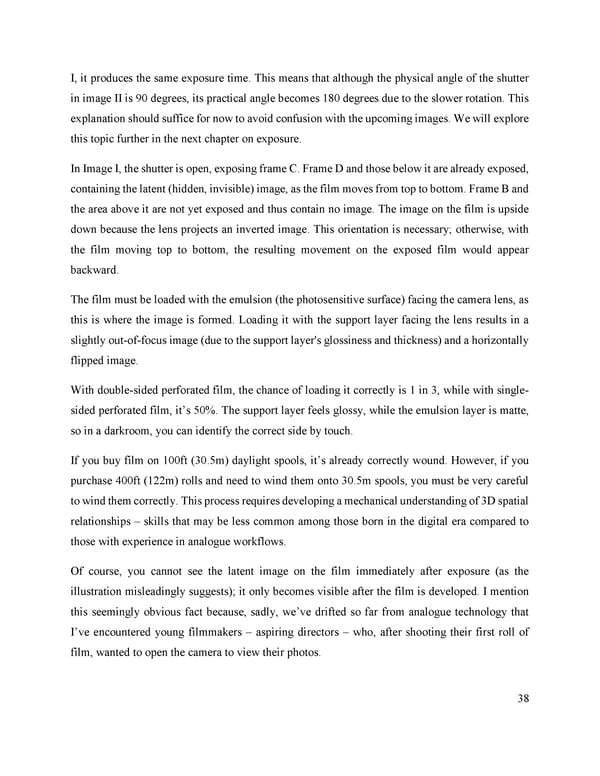I, it produces the same exposure time. This means that although the physical angle of the shutter in image II is 90 degrees, its practical angle becomes 180 degrees due to the slower rotation. This explanation should suffice for now to avoid confusion with the upcoming images. We will explore this topic further in the next chapter on exposure. In Image I, the shutter is open, exposing frame C. Frame D and those below it are already exposed, containing the latent (hidden, invisible) image, as the film moves from top to bottom. Frame B and the area above it are not yet exposed and thus contain no image. The image on the film is upside down because the lens projects an inverted image. This orientation is necessary; otherwise, with the film moving top to bottom, the resulting movement on the exposed film would appear backward. The film must be loaded with the emulsion (the photosensitive surface) facing the camera lens, as this is where the image is formed. Loading it with the support layer facing the lens results in a slightly out-of-focus image (due to the support layer's glossiness and thickness) and a horizontally flipped image. With double-sided perforated film, the chance of loading it correctly is 1 in 3, while with single- sided perforated film, it’s 50%. The support layer feels glossy, while the emulsion layer is matte, so in a darkroom, you can identify the correct side by touch. If you buy film on 100ft (30.5m) daylight spools, it’s already correctly wound. However, if you purchase 400ft (122m) rolls and need to wind them onto 30.5m spools, you must be very careful to wind them correctly. This process requires developing a mechanical understanding of 3D spatial relationships – skills that may be less common among those born in the digital era compared to those with experience in analogue workflows. Of course, you cannot see the latent image on the film immediately after exposure (as the illustration misleadingly suggests); it only becomes visible after the film is developed. I mention this seemingly obvious fact because, sadly, we’ve drifted so far from analogue technology that I’ve encountered young filmmakers – aspiring directors – who, after shooting their first roll of film, wanted to open the camera to view their photos. 38
 Lost Analogue: Exploring Film, Music, and Interdisciplinary Methods in Education Page 38 Page 40
Lost Analogue: Exploring Film, Music, and Interdisciplinary Methods in Education Page 38 Page 40